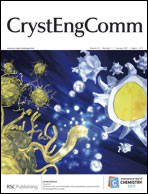The purpose of this work is to systematically investigate the influence of the functional co-ligands and metal ions on the self-assembly and properties of the in situ generated 5-(pyrazinyl)tetrazolate (ptz−)-based metal complexes. A series of nine metal complexes, {[Co3(H2O)4(ptz)2(btec)]·5H2O}n (1), [Cu2(H2O)4(ptz)2(H2btec)]n (2), [Hg2(ptz)2Cl2]n (3), [Hg3(H2O)2(ptz)4(μ1,1-N3)2]·2H2O (4), Hg(H2O)2(ptz)2 (5), [Cd2(H2O)2(ptz)2(ox)]n (6), [Cd(H2O)(ptz)I]n (7), {[Cd(H2O)(ptz)X]·H2O}n (X = Br for 8 and Cl for 9) (btec = 1,2,4,5–benzenetetracarboxylate and ox = oxalate), was obtained by a subtle variation of co-ligands and metal ions, in which the HgII ion is firstly observed as an efficient Lewis acid to catalyze the in situ reaction. Significantly, resulted from the cooperative and/or competitive binding between the mixed ligands and the metal ions with different coordination geometry, complexes 1–9 feature interesting structural subunits (mono-, bi- and tri-metallic core) and various dimensionalities ranged from polymeric three-dimensional (3D) frameworks to discrete zero-dimensional (0D) entities. Three high-dimensional complexes with a binodal (3,8)-connected tfz-d microporous framework for 1, a trinodal (3,4)-connected unusual (6·82)2(6·83·102) topology for 3, and a six-connected α-polonium-type network for 6 are observed, respectively. Complexes 2 and 7–9 are bi-metallic node-based 2D layers (7) and 1D chains (2, 8, and 9). In contrast, the rarely linear tri-metallic core and commonly observed mononuclear entities are generated for 4 and 5, respectively. Additionally, CuII-based polymer 2 displays weak intra-dimeric antiferromagnetic coupling interaction. Complexes 1 and 3–9 with considerable metal ion-dependent thermal stability exhibit ptz−-based photoluminescence with variable intensity.


 Please wait while we load your content...
Please wait while we load your content...